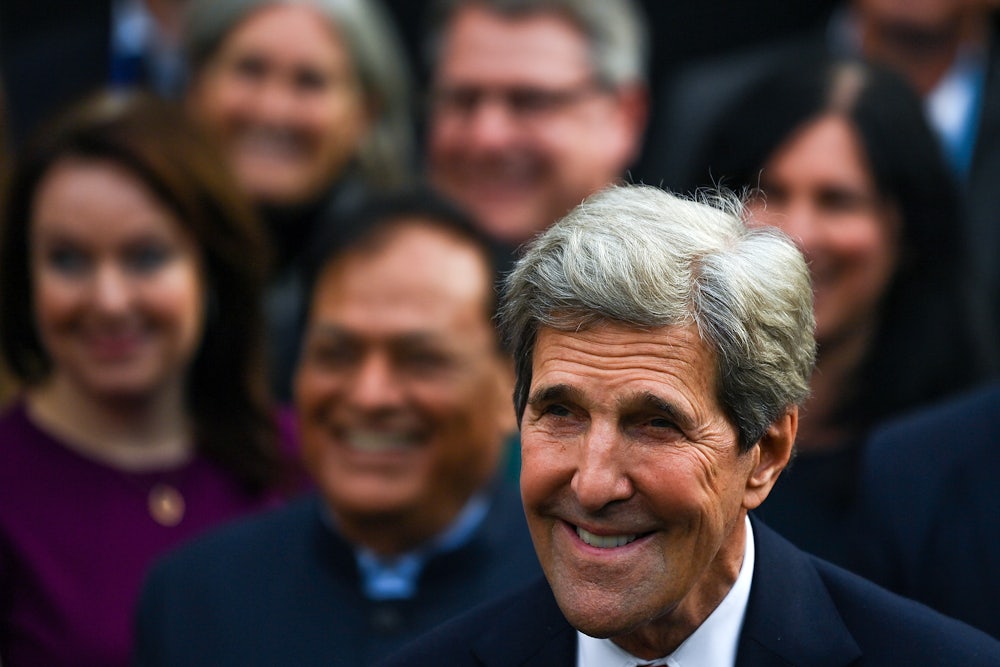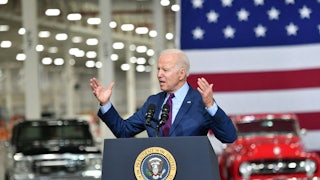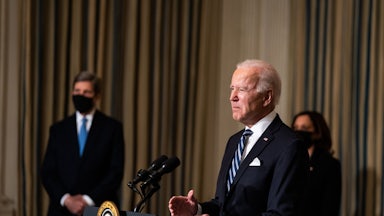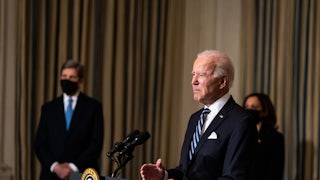The private sector is already well on its way to solving the climate crisis. That, at least, is what Biden administration officials attending the U.N. Climate Change Conference, or COP26, this week are trying to convince themselves while facing the legislative defeat of the White House’s climate spending proposals back home.
International climate envoy John Kerry, looking a little worse for wear after several long days along the Clyde, struck an optimistic note: “Blend the finance, de-risk the investment, and … create the capacity to have bankable deals,” he told a side event for reporters that didn’t accept questions. “That’s doable for energy. It’s doable for water. That’s doable for transportation.” After COP26, Kerry added, “we’ll be transitioning my team directly into a hand-holding aid agency that’s going to be out there working with each of these countries,” referring to developing nations.
Trump’s infamously long list of regulatory rollbacks, White House National Climate Adviser Gina McCarthy said in the same makeshift little room, about an hour later, “didn’t actually make that big of a difference in the private sector because they already knew where they needed to go. I’m so excited that the private sector is here with such vibrance. There’s no question any more that this is a catastrophe and we have to fix it. The question is, how do we do it in a way that captures the economic value associated with that?”
“We do have to turn this challenge,” McCarthy added, “into a creative opportunity. And all that will make money. And God bless America.” That event wasn’t taking questions from reporters, either. The White House hasn’t responded to a request for comment.
“The old notions of why the private sector should decarbonize—because planet must be put before profit—are no longer universally true,” Treasury Secretary Janet Yellen (the first U.S. treasury secretary to address U.N. climate talks) said, elsewhere at the conference, on Wednesday. “Many renewables are now cheaper than carbon-based fuel alternatives and have lower long-term operating costs. Other green technologies have cost curves that continue to plunge. In many cases, it is simply cost effective to go green.”
Optimism was in the canned air of the Scottish Events Center. It was “Finance Day,” one of several themed days spotlighting efforts in different sectors to reduce emissions. Bank of England head turned green banking guru Mark Carney had just announced that $130 trillion worth of assets were now signed on to something called the Glasgow Financial Alliance for Net Zero, or Gfanz. Practically speaking, that means private sector financial institutions that control that much money said they would at some point write a plan to eventually transition their considerable portfolios to net-zero, whatever that means.
That did not include commitments from those same banks, insurance companies, or asset managers to stop financing coal, oil, or gas, as many Gfanz companies are. A report from the nonprofit Rainforest Action Network in March found that JP Morgan Chase—which joined the alliance yesterday—has furnished $317 billion to fossil fuel companies since 2016. As of yesterday, all of the top 10 fossil fuel financiers RAN identified are now Gfanz members. Last year alone, they collectively contributed $303 billion to coal, oil, and gas projects. As members of Gfanz, they might opt to disclose those investments or also to finance more climate-friendly things. Grand pledges, from those made by financiers to the multination methane-reduction pledge, have been a theme at this year’s COP. None of these pledges contain tools to turn those pledges into reality or enforce them in any way—much like the Paris Agreement that this conference is ostensibly meant to help implement.
Once upon a time not too long ago, a stronger form of climate commitment from financial institutions looked possible. As the world sought to keep the global economy from imploding amid the Covid-19 pandemic, the power of central banks—particularly the U.S. Federal Reserve—appeared basically unlimited. Old norms about fiscal responsibility seemed to vanish in the face of such urgent need. Many hoped politicians would treat the climate crisis similarly.
Now grandstanding about fiscal prudence is back. “That idea disappeared very quickly as soon as the market conditions changed, and once you saw a little bit of inflation coming up,” said Daniela Gabor, an economist at the University of the West of England, Bristol, who’s written extensively on green finance. “Unless you have a change in the macrofinancial paradigm—how we organize our macrofinancial institutions and their relationship to finance capital—you will not get the kinds of structural transformations that you hope for, where the state organizes the low-carbon transition. It was a temporary blip.”
Gabor also posed a more troubling question: “To what extent is the Biden administration counterproductive here?” she asked. On the one hand, the United States pulling out of the Paris Agreement under Trump—and taking a generally combative stance toward international agreements—was disastrous. On the other, it ramped up pressure on the rest of the world to pick up its slack. Now that the Biden administration has brought the U.S. back in, “everything goes back to the baseline of the U.S. And the baseline of the U.S. is that the Federal Reserve can’t do anything.”
The argument the U.S. and other wealthy countries have been making this week is that the primary goal of public climate investments should be to transform desperately needed climate projects into profitable investments, shouldering the risk corporations are unwilling to take to save the world. There is now genuine money to be made in green sectors like renewables, for instance. But it’s difficult to imagine that the trillions needed to clean up from climate disasters—known as loss-and-damage funds—will ever generate the kinds of yields investors are hungry for.
Beyond the fear that those private-sector funds will never actually be “mobilized” at the scale needed, there are other concerns about the strings attached to the projects they do finance. Turning public goods into asset classes means building in opportunities to generate returns, like slapping hefty tolls onto Goldman Sachs–built highways or charging extortionate rates for electric vehicle charging. That’s because the goal of these policies isn’t to lower emissions; it’s to generate returns to lower emissions. Making sure investors can tap into the “enormous commercial opportunities in the transition to net-zero” is “embedded” into the green financing framework Carney released this week. “The idea is that you can have monetary and fiscal austerity again because BlackRock will come in and save the day with a little bit of blended finance,” Gabor said. On a CNBC-hosted panel at COP26, Larry Fink, BlackRock’s CEO, announced that his firm had raised $673 million to fund “climate-focused infrastructure” in developing countries.
By utilizing an “innovative leveraging structure,” Yellen said the new green bonds she announced this week “will help attract significant new private climate finance and provide $500 million per year” to finance public and private initiatives through the Climate Investment Funds Capital Markets Mechanism. As Kerry put it in a recent press call—after noting there were trillions available for green things—“the issue is actually deploying those trillions of dollars, because they need to be for bankable, you know, investable deals.”
With understandably waning confidence in their own ability to govern, the most climate-conscious public figures in the administration have doubled down on making climate infrastructure a good deal for private investors with deep pockets. That’s probably not such a good deal, though, for the planet and its less wealthy inhabitants.










